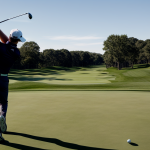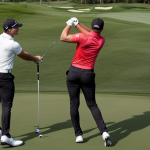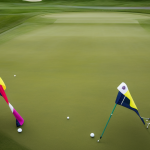Golf is a sport that requires a unique combination of physical, mental, and strategic skills. To become a proficient golfer, one must master various techniques and develop a deep understanding of the game. This guide will provide an overview of the essential skills and techniques required to excel in golf. From swing mechanics to mental toughness, we will explore the key elements that differentiate good golfers from great ones. So, if you’re looking to improve your game and take your skills to the next level, read on to discover the secrets of mastering the art of golf.
Golf Equipment: Selecting the Right Clubs for Your Game
Drivers
Factors to Consider
When selecting a driver, there are several key factors to consider. These include:
- Loft angle: The loft angle of a driver determines the height and distance of the ball flight. A higher loft angle will result in a higher, shorter shot, while a lower loft angle will produce a longer, lower shot.
- Shaft material and flex: The shaft material and flex can greatly affect the driver’s performance. Graphite shafts are lighter and more flexible, making them a popular choice for many golfers. Steel shafts, on the other hand, are heavier and less flexible, providing more control for more experienced players.
- Clubhead size and shape: The size and shape of the clubhead can also impact the driver’s performance. Larger clubheads can increase the ball’s speed and distance, while smaller clubheads may offer more control and accuracy.
Recommended Clubs for Different Skill Levels
For golfers at different skill levels, there are recommended drivers that can help improve their game. These include:
- Beginners: High-loft drivers are ideal for beginners as they provide maximum distance and ease of use. These drivers have a higher loft angle and a larger clubhead, making it easier to hit the ball straight and far.
- Intermediate: Adjustable drivers are recommended for intermediate golfers. These drivers allow the golfer to adjust the loft and face angle of the club, providing customizable performance for different shots and situations.
- Advanced: Low-spin drivers are ideal for advanced golfers who want more control over their shots. These drivers have a lower loft angle and a smaller clubhead, resulting in less spin and more roll on the ball, allowing for increased control and accuracy.
Irons
- Loft angle: The loft angle of an iron refers to the angle between the clubface and the ground plane when the club is in address position. A higher loft angle leads to shorter distance but greater control, while a lower loft angle results in longer distance but reduced control.
- Shaft material and flex: The shaft is the backbone of the club, and its material and flex directly impact the golfer’s performance. Graphite shafts are lighter and offer greater flexibility, making them suitable for slower swing speeds or those seeking increased distance. Steel shafts, on the other hand, are heavier and less flexible, providing a more stable and accurate shot for faster swing speeds.
-
Clubhead size and shape: The size and shape of the clubhead influence the golfer’s ball trajectory and spin rate. A larger clubhead typically produces a lower ball flight with more spin, while a smaller clubhead results in a higher ball flight with less spin.
-
Beginners: Game-improvement irons for consistency and distance
- Features:
- Larger clubhead for improved accuracy
- Lower loft angles for added distance
- Forgiving design for inconsistent swings
- Examples: Callaway Big Bertha, TaylorMade M4, Titleist 718 AP1
- Features:
- Intermediate: Players’ irons for increased control and precision
– Smaller clubhead for improved control
– Moderate loft angles for balanced distance and control
– More compact design for improved feel and control- Examples: Titleist 718 AP2, Mizuno JPX 900 Forged, Cleveland Launcher HB
- Advanced: Tour-preferred irons for maximum distance and control
– Compact clubhead for precise control
– High loft angles for optimal ball trajectory
– Tour-validated designs for enhanced performance- Examples: PXG 0311 XF, TaylorMade P7MC, Mizuno MP-20 MMC
Putters
When selecting a putter, there are several factors to consider. These include the style of the putter, the material and length of the shaft, and the weight and balance of the club.
- Mallet or blade style: The style of the putter can affect the accuracy and control of your shots. Mallet putters have a larger sweet spot and are more forgiving, making them a good choice for beginners. Blade putters, on the other hand, have a smaller sweet spot and require more precision, making them a better choice for advanced players.
- Shaft material and length: The material and length of the shaft can also affect the performance of the putter. Graphite shafts are lighter and provide more flexibility, while steel shafts are heavier and offer more stability. The length of the shaft should be chosen based on the player’s height and putting stroke.
- Weight and balance: The weight and balance of the putter can affect the feel and control of the club. A heavier putter can provide more stability, while a lighter putter can offer more control. The balance of the putter should be chosen based on the player’s personal preference and stroke style.
Recommended Putters for Different Skill Levels
Different skill levels require different putters to optimize their performance on the golf course.
- Beginners: High-MOI mallet putters are a good choice for beginners as they offer more forgiveness and accuracy. These putters have a larger sweet spot and are easier to use, making them ideal for those who are still learning the game.
- Intermediate: Mid-mallet or blade putters are a good choice for intermediate players. These putters offer more control and precision than high-MOI mallet putters, making them ideal for those who have developed their skills and are looking to improve their game.
- Advanced: Small-headed, low-MOI putters are a good choice for advanced players. These putters require more precision and skill to use, making them ideal for those who have mastered the basics and are looking to take their game to the next level.
Golf Swing Techniques: Developing a Smooth and Effective Motion
Grip and Stance
Proper Grip Technique
- Lightly overlap the hands: When holding the golf club, the hands should be placed in such a way that the left hand is slightly ahead of the right hand. The hands should be lightly overlapped, with the pinky finger of the right hand resting on top of the left hand’s index finger. This grip positioning allows for better control and accuracy during the swing.
- Place the right hand on the grip: The right hand should be placed on the grip of the golf club, with the thumb resting on the bottom right corner of the grip. The index, middle, and ring fingers should be positioned in the center of the grip, while the pinky finger should be resting on top of the left hand’s index finger.
- Point the fingers of the left hand toward the left shoulder: The left hand should be placed on the grip with the fingers pointing toward the left shoulder. The thumb of the left hand should be positioned parallel to the right hand’s thumb, and the index finger should be slightly extended, with the middle, ring, and pinky fingers tucked into the palm.
Proper Stance
- Stand with the balls of your feet facing the target: When assuming the stance, the golfer should stand with the balls of their feet facing the target. This positioning allows for better balance and stability during the swing.
- Position the feet shoulder-width apart: The golfer’s feet should be positioned shoulder-width apart, with the left foot slightly ahead of the right foot. This stance ensures proper balance and allows for a smooth, powerful swing.
- Keep your knees slightly bent for stability: The knees should be slightly bent to provide stability and balance during the swing. Bending the knees also allows for a more efficient transfer of power from the legs to the upper body during the swing.
Backswing and Downswing
Proper Backswing
- Start with the club parallel to the ground: Begin your backswing by positioning the club parallel to the ground, ensuring that your hands are placed appropriately on the grip. This setup will allow you to maintain control and prevent the club from twisting or rotating during the swing.
- Slowly lift the club up to the top of the backswing: As you initiate the backswing, focus on smoothly lifting the club upward, keeping it close to your body. The top of the backswing should be reached when your arms are fully extended and the club is parallel to the ground once again.
- Keep the clubhead from rotating or twisting: Throughout the backswing, pay close attention to preventing the clubhead from rotating or twisting. This will help ensure a straight and consistent shot, reducing the likelihood of slicing or hooking the ball.
Proper Downswing
- Accelerate the club through impact: As you approach the point of impact, it’s crucial to accelerate the clubhead, maintaining a steady speed and smooth motion. This will help you maximize the power and distance of your shot.
- Maintain a straight arm for accuracy: As you begin the downswing, keep your arm straight to ensure that the clubface remains square to the target. This will help you maintain accuracy and prevent hooks or slices.
- Use your body weight to generate power: As you swing the club, utilize your body weight and core muscles to generate power. Rotate your hips and torso, allowing your arms to follow naturally, and keep your lower body stable for maximum efficiency.
Short Game Fundamentals: Mastering Pitching, Chipping, and Putting
Pitching
Pitching is a crucial aspect of the short game in golf, and it involves hitting the ball from a distance of less than 30 yards to the hole. The goal of pitching is to get the ball as close to the hole as possible, while minimizing the number of strokes taken. To achieve this, golfers must master proper technique, avoid common mistakes, and develop the ability to control the trajectory and distance of their shots.
Proper Technique
- Choose a lofted club for higher shots: When pitching, golfers should use a lofted club, such as a sand wedge or lob wedge, to increase the height and distance of their shots. This is because the ball will not roll as far when it lands, and a higher shot will give the golfer a better chance of getting close to the hole.
- Play the ball back in your stance: To maintain control over the shot, golfers should play the ball back in their stance, positioning it just behind their front foot. This will help them to make a more compact swing, which is essential for accuracy and control.
- Maintain a steady, rhythmic motion: When pitching, golfers should focus on maintaining a steady, rhythmic motion, using their hands and arms to control the clubhead. They should avoid using their lower body, as this can lead to an uncontrolled, erratic swing.
Common Mistakes
- Lifting the head during the swing: One common mistake that golfers make when pitching is lifting their head during the swing. This can cause them to lose sight of their target, and it can also lead to an uncontrolled, erratic swing.
- Using an excessive amount of wrists: Another common mistake is using an excessive amount of wrists, which can cause the ball to veer off course and miss the target. Golfers should use their hands and arms to control the clubhead, avoiding any excessive movements of the wrists.
- Standing too far from the ball: Golfers should avoid standing too far from the ball when pitching, as this can lead to an uncontrolled, erratic swing. Instead, they should position themselves closer to the ball, and focus on making a more compact, controlled swing.
Chipping
Chipping is an essential part of golf that involves hitting the ball a short distance from the green or the fairway. Mastering the art of chipping can help golfers score better and avoid losing strokes. In this section, we will discuss the proper technique and common mistakes to avoid when chipping.
Proper technique is crucial when chipping. Here are some tips to help you master the art of chipping:
- Use a lower-lofted club for control: When chipping, it is important to use a lower-lofted club to control the distance and trajectory of the ball. A lower-lofted club allows for more control and accuracy when hitting the ball.
- Play the ball in the center or forward in your stance: When setting up for a chip shot, it is important to play the ball in the center or slightly forward in your stance. This will help you make a shallow, partial swing and prevent the ball from ballooning.
- Make a shallow, partial swing: When making a chip shot, it is important to make a shallow, partial swing. This will help you control the distance and trajectory of the ball and prevent it from ballooning.
Here are some common mistakes to avoid when chipping:
- Using too much force: One of the most common mistakes when chipping is using too much force. It is important to make a shallow, partial swing to control the distance and trajectory of the ball. Using too much force can cause the ball to balloon and lead to poor contact.
- Taking an extra divot: Another common mistake when chipping is taking an extra divot. This can cause the ball to come out low and slow, leading to poor contact and missed shots.
- Not paying attention to body positioning: Body positioning is crucial when chipping. Golfers should keep their weight centered on their feet and their knees slightly bent to maintain balance and control. Not paying attention to body positioning can lead to poor contact and missed shots.
Putting
Putting is one of the most critical aspects of golf, as it is the final step in determining the outcome of each hole. Mastering the art of putting requires a combination of technical skill, mental focus, and physical strength.
To master the art of putting, it is essential to have the correct technique. This involves using a smooth, pendulum-like motion to keep the putterhead moving in a straight line towards the target. It is crucial to keep your eyes on the ball throughout the stroke, as this will help you to make the most accurate contact possible. Finally, it is essential to finish with your hands in front of your body, as this will help to prevent any unwanted tension from creeping into your stroke.
Many golfers make common mistakes when putting, which can significantly impact their performance. One of the most common mistakes is pushing or pulling the ball, which can result in the ball not traveling in a straight line towards the target. Another mistake is lifting the head during the stroke, which can cause the ball to be hit too high or too low. Finally, many golfers do not use enough force when putting, which can result in the ball being hit too weakly and failing to reach the target.
By avoiding these common mistakes and focusing on proper technique, golfers can master the art of putting and significantly improve their performance on the golf course.
Physical Fitness and Mental Toughness: Keys to Success on the Golf Course
Physical Fitness
Physical fitness is a crucial aspect of golf performance. It is important for golfers to maintain a certain level of physical fitness to improve their overall game. In this section, we will discuss the importance of stretching and warm-up exercises, as well as specific exercises that can enhance golf performance.
Importance of Stretching and Warm-up Exercises
Stretching and warm-up exercises are essential for improving flexibility and mobility, preventing injury, and improving performance on the golf course. Stretching helps to increase the range of motion in the joints, which can improve the golfer’s ability to swing the club with ease and precision. Warm-up exercises, such as light cardio and dynamic stretches, help to increase blood flow and oxygenation to the muscles, which can improve performance and reduce the risk of injury.
Exercises to Enhance Golf Performance
There are several exercises that can help to enhance golf performance. These include:
- Yoga and Pilates: These exercises can help to improve balance, core strength, and flexibility. They can also help to improve posture and reduce the risk of injury.
- Resistance training: Resistance training can help to improve power and endurance on the golf course. Exercises such as weightlifting and resistance band exercises can help to build strength and improve overall fitness.
- Cardiovascular exercises: Cardiovascular exercises, such as running and cycling, can help to improve overall fitness and endurance. They can also help to reduce stress and improve mental focus on the golf course.
Overall, incorporating physical fitness into a golf training regimen can help to improve performance, reduce the risk of injury, and enhance overall well-being on the golf course.
Mental Toughness
Importance of Positive Thinking
Positive thinking is a crucial aspect of mental toughness in golf. It can enhance focus and concentration, reduce anxiety and stress, and improve overall performance. Golfers who maintain a positive attitude throughout their round are better equipped to handle setbacks and remain confident in their abilities. To cultivate positive thinking, golfers should:
- Practice self-talk: Encourage yourself with positive affirmations, such as “I can do this” or “I’m playing well today.”
- Focus on strengths: Identify your strengths as a golfer and emphasize them during your round.
- Reframe negative thoughts: Transform negative thoughts into positive ones by asking yourself, “What can I learn from this mistake?” or “How can I use this experience to improve?”
Visualization Techniques
Visualization is a powerful tool for mental toughness in golf. By imagining successful shots and swings, golfers can build confidence and enhance their performance on the course. Visualization techniques include:
- Imagine successful shots: Envision yourself making perfect contact with the ball, followed by the ball flying straight and true towards the target.
- Use mental rehearsal: Practice your swing in your mind, focusing on the positive outcomes and feeling the sensations of a successful shot.
- Visualize the perfect ball flight: Close your eyes and picture the ball flying towards the target, landing softly and rolling towards the hole.
In addition to visualization, mental toughness also involves developing resilience, adaptability, and the ability to stay present in the moment. Golfers should practice techniques such as deep breathing, mindfulness, and progressive muscle relaxation to improve their mental toughness and overall performance on the golf course.
Recap of Essential Skills and Techniques
Selecting the right golf clubs for your game is a crucial aspect of golf performance. Each club serves a specific purpose, and selecting the right one for your game can help you hit the ball further and straighter. Factors to consider when selecting golf clubs include your swing speed, ball speed, and shot shape. It is essential to have a set of clubs that suits your playing style and abilities.
Developing a smooth and effective golf swing is another critical skill for optimal performance on the golf course. A good golf swing involves several key elements, including grip, stance, and body positioning. It is important to practice good posture and maintain a balanced position throughout the swing. The swing should be smooth and rhythmic, with a smooth transition from the backswing to the downswing.
Mastering the fundamentals of the short game is also essential for success on the golf course. The short game involves shots within 100 yards of the green, and it is crucial to have a solid technique for these shots. The short game requires a high level of control and precision, and mastering it can help you save strokes and improve your overall score. Key elements of the short game include chipping, pitching, and putting.
Improving physical fitness and mental toughness is also critical for success on the golf course. Golf is a physically demanding sport that requires strength, endurance, and flexibility. Regular exercise and stretching can help improve your physical fitness and reduce the risk of injury. Mental toughness is also essential for success on the golf course. It involves developing the ability to stay focused and composed under pressure, and it can be improved through visualization exercises and other mental training techniques.
In summary, mastering the essential skills and techniques for optimal performance on the golf course involves selecting the right golf clubs, developing a smooth and effective golf swing, mastering the fundamentals of the short game, and improving physical fitness and mental toughness. By focusing on these key areas, golfers can improve their performance and achieve their goals on the golf course.
Final Tips for Optimal Performance
In order to achieve optimal performance on the golf course, it is important to keep in mind a few final tips that can help improve your physical fitness and mental toughness.
Stay hydrated and nourished during play
Hydration and proper nutrition are essential for maintaining peak physical performance during a round of golf. It is important to bring plenty of water and snacks to keep your energy levels up and prevent dehydration. Additionally, it is important to eat a balanced diet in the days leading up to a round of golf to ensure that you have the necessary nutrients to perform at your best.
Learn from your mistakes and adjust your techniques
No one is perfect, and it is important to learn from your mistakes on the golf course. If you hit a bad shot, take a moment to analyze what went wrong and how you can adjust your technique to prevent it from happening again in the future. By learning from your mistakes, you can improve your overall performance and reduce your scores.
Practice regularly to develop muscle memory
As with any sport, practice is key to improving your skills and techniques on the golf course. Regular practice can help develop muscle memory, which can improve your swing and overall performance. It is important to practice a variety of shots and scenarios to prepare for any situation that may arise on the course.
Enjoy the game and have fun!
Above all, it is important to remember that golf is a game and should be enjoyed. By focusing too much on your performance and not having fun, you may become too stressed and lose sight of the enjoyment that comes with playing the game. Remember to take a deep breath, relax, and enjoy the beautiful surroundings of the golf course. By doing so, you will be more likely to perform at your best and have a positive experience on the course.
FAQs
1. What are the essential skills and techniques required to be good at golf?
To be good at golf, there are several essential skills and techniques that you need to master. These include having a good swing, controlling your ball flight, managing your distance and trajectory, and having good putting skills. You also need to have good course management skills, such as knowing how to navigate hazards and avoid penalties.
2. What is the most important skill to have in golf?
The most important skill to have in golf is a good swing. Your swing is the foundation of your game and it determines how far and accurately you can hit the ball. A good swing involves a number of different elements, including grip, stance, posture, and follow-through. It’s important to practice your swing regularly to develop good muscle memory and consistency.
3. How can I improve my putting skills?
Improving your putting skills requires practice and focus. Start by paying attention to your grip, stance, and aim. Make sure your hands are relaxed and your eyes are focused on the hole. Try to use a consistent stroke and keep your head still during the putt. It’s also helpful to practice on different types of greens and from different distances to build your confidence and accuracy.
4. What is the best way to manage my distance and trajectory in golf?
Managing your distance and trajectory in golf involves a number of factors, including club selection, ball choice, and swing technique. You need to choose the right club for the distance and trajectory you want to achieve, and use a swing that allows you to control the ball’s flight. Practice your swing on different distances and trajectories to develop your accuracy and control.
5. How can I manage hazards and avoid penalties in golf?
Managing hazards and avoiding penalties in golf requires knowledge of the rules and the course. Study the course map and familiarize yourself with the hazards, such as bunkers and water hazards. Pay attention to the rules and be aware of potential penalty situations, such as hitting a ball out of bounds or into a hazard. Practice your shot selection and risk management to minimize the chances of encountering hazards and penalties.









